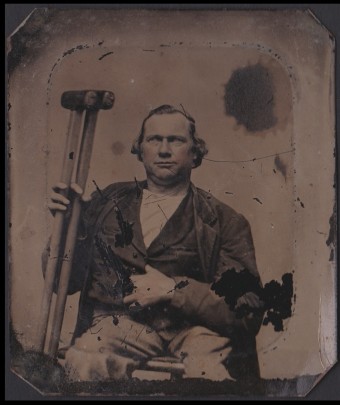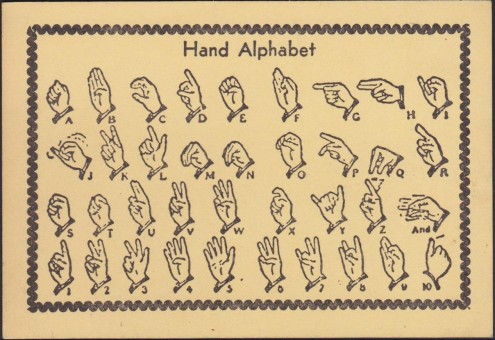Blog
25 Nov 2013 UK Disability History Month Blogs 2013: Collecting Disability History - Nicole Belolan
I never thought I would be one of those scholars studying material culture who collected what they researched.* I always thought those people wasted time and money better spent doing their work. That is, until I found that collecting what I researched was fun and that it enhanced what I did professionally.
[fig. 1: Detail of mid nineteenth-century crutch. (Author’s collection)]
As a scholar of disability and material culture in early America, the inspiration to collect began when my partner gave me a unique nineteenth-century crutch one Christmas. Otherwise ordinary, the crutch features several sets of engraved initials [fig. 1]. Did the initials represent multiple individuals who used the crutch, possibly in an institutional or martial setting? Were they there because friends and family “signed” the crutch, the way we sign a cast today? Either way, I was thrilled with the gift, and I display it proudly against a wall near other artifacts — ranging from nineteenth-century moralistic ceramics to mid-twentieth-century sign language ephemera — I have since added to my collection.
The largest part of my collection is made up of historic photographs. When I completed my comprehensive exams for my PhD last December, like many of my colleagues, I had to work at finding new thoughts and activities to fill the time that had been stuffed with reading and writing non-stop for about five months. My partner was already an avid eBay “watcher” of historic photographs, and he got me started monitoring the popular auction site for images related to my research interests. There are a lot of “instant family” members (a cute way some antique dealers label baskets of unidentified historic photographs for sale) on eBay, and I got overwhelmed rather quickly. But then I started finding some historic friends for auction accompanied by descriptions using the words with which I was quite familiar as a researcher: crutch, cripple, disabled, amputee. I was already an avid antiquer who had cut her teeth on the country flea market scene in rural Pennsylvania. I even maintain a blog about my hobby. But it had not occurred to me to seek out items related to disability history on eBay. Somehow that seemed like cheating, but once I started, I couldn’t stop.
[fig. 2: Tintype of 1860s man with crutches. (Author’s collection)]
My first purchase was of this anonymous man [fig. 2]. He’s a bit dinged up, but with his tinted cheeks, bright eyes, and rumpled suit, he has character. In addition to having an interesting face, he also held up two crutches in his right hand. I was already familiar with similar historic photographs that depicted ordinary people with disabilities. In fact, Robert Bogdan devoted a chapter to them in his recent book Picturing Disability (2012). But I never dreamed I’d acquire my own. They never showed up in antique shops. Yet here they were on eBay. Not cheap, but not out of reach. And so within a week’s time, after a short but intense bidding war, my new friend, arrived safely in my mailbox.
And so began a collecting spree that has not waned a year later.
[Left: fig. 3: Tintype of late nineteenth-century wheelchair user and friends or family. Right: fig. 4: Tintype of late nineteenth- or early twentieth-century man with crutch and cane. (Both author’s collection)]
I have photographs of men, women, and children of all ages and walks of life. Most carried crutches. One used a wheelchair [fig. 3]. Some boasted a crutch and a cane [fig. 4]. One man appears that he may have been of short stature—not to mention proud. And why not? He was a snappy dresser and chose a sublime backdrop for his portrait [fig. 5].
[fig. 5: Tintype of late nineteenth- or early twentieth-century man with crutches. (Author’s collection)]
There’s something to be said about the thrill of the hunt, but what could I possibly be getting out of this that I didn’t as a mere researcher?
First and foremost, I use these items for my work. My dissertation is about how people with disabilities in early America (about 1700-1861) used objects ranging from gout cranes to adult cradles to peg legs to get around (or stay in one place) at home, on the street, and in the institution and what this means. Most of the disability-related items on the market that I can afford post-date or date from the tale end of the era I study. But there’s still much to be learned from my friends. Lining them up before me puts the people into the history, making tangible the fact that disability crossed gender, age, and class historically and today. The fact that so many of these people carried crutches into the photo studio reinforces the long-time utility of that simple yet pervasive artifact, the crutch. And the photos raise the question as to why objects associated with disability were deemed appropriate photographic props at that time and in those contexts (and not necessarily at other times in history or in other contexts).
[fig. 6: “Hand Alphabet” promotional card, published by the “Smile Deaf Mute Educational System,” probably 1940s. (Author’s collection)]
Collecting these items has also taught me a lot about contemporary Americans’ understanding of disability. For instance, many eBay sellers use terminology to describe these individuals — such as cripple and handicapped — that we tend to consider outdated and offensive today. In one instance, when I declared my intention to purchase two “deaf mute educational system” cards at a local antique mall checkout counter, the attendant performed a tasteless imitation of a deaf person using gestures meant to represent sign language and a “deaf accent” [fig. 6]. And, of course, I have learned about aspects of disability history of which I was not previously aware. For instance, after a colleague tipped me off to their availability at the local farmers’ market antique stall, I snapped up a few eye-catching stamps and envelopes associated with the International Year of Disabled Persons, a celebration with which I was unfamiliar until then. This 1981 celebration, I learned from an envelope, emphasized “the adjustments disabled persons make to achieve integration into society.” This philosophy, which embodies the idea that disabled people can “overcome” their “challenges,” has since fallen out of favor with some disabled people and scholars alike since it suggests the “problem” is with the individual and not with the society or culture in which they live.
How can I deploy my research and collecting to give contemporary Americans a better sense of how people experienced disability in the past and how those experiences connect to our relationship with disability today?
I can use my blogging venues as an outlet for public outreach. The portability of what I collect enables me to bring these artifacts into the classroom and lecture hall, too. My mid-nineteenth-century gout stool made an appearance in a research and writing seminar I took, and my crutches have proven to hit home with a lot of people. As one of my dissertation committee members declared after I used a crutch as a prop for a talk, “we’ve all been there, right”?
We have. What does disability tell us about what it means to be human? Far from a waste of time and money, I’ll continue to collect disability history, if only to continue formulating answers to that question.
* I am defining material culture broadly here as or anything made or modified by humans ranging from landscapes to furniture to photographs to silver spoons.
Nicole Belolan is a PhD candidate in the History of American Civilization Program at the University of Delaware. She is working on a dissertation about physical impairments and material culture at home, on the street, and in the institution in early America and lectures regularly on her research. She is the author of “Object Lesson: Desire Tripp and Her Arm’s Gravestone,” published in Common-Place: http://www.common-place.org/vol-13/no-03/lessons/
Guest post for Disability and Industiral Society's UK Disability History Month Blogs 2013.




